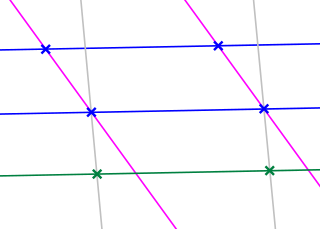Related Research Articles

In mathematics, affine geometry is what remains of Euclidean geometry when ignoring the metric notions of distance and angle.

In mathematics, an algebraic group is an algebraic variety endowed with a group structure which is compatible with its structure as an algebraic variety. Thus the study of algebraic groups belongs both to algebraic geometry and group theory.

A finite geometry is any geometric system that has only a finite number of points. The familiar Euclidean geometry is not finite, because a Euclidean line contains infinitely many points. A geometry based on the graphics displayed on a computer screen, where the pixels are considered to be the points, would be a finite geometry. While there are many systems that could be called finite geometries, attention is mostly paid to the finite projective and affine spaces because of their regularity and simplicity. Other significant types of finite geometry are finite Möbius or inversive planes and Laguerre planes, which are examples of a general type called Benz planes, and their higher-dimensional analogs such as higher finite inversive geometries.
Noncommutative geometry (NCG) is a branch of mathematics concerned with a geometric approach to noncommutative algebras, and with the construction of spaces that are locally presented by noncommutative algebras of functions. A noncommutative algebra is an associative algebra in which the multiplication is not commutative, that is, for which does not always equal ; or more generally an algebraic structure in which one of the principal binary operations is not commutative; one also allows additional structures, e.g. topology or norm, to be possibly carried by the noncommutative algebra of functions.

In mathematics, an affine space is a geometric structure that generalizes some of the properties of Euclidean spaces in such a way that these are independent of the concepts of distance and measure of angles, keeping only the properties related to parallelism and ratio of lengths for parallel line segments.

Discrete geometry and combinatorial geometry are branches of geometry that study combinatorial properties and constructive methods of discrete geometric objects. Most questions in discrete geometry involve finite or discrete sets of basic geometric objects, such as points, lines, planes, circles, spheres, polygons, and so forth. The subject focuses on the combinatorial properties of these objects, such as how they intersect one another, or how they may be arranged to cover a larger object.

In mathematics, incidence geometry is the study of incidence structures. A geometric structure such as the Euclidean plane is a complicated object that involves concepts such as length, angles, continuity, betweenness, and incidence. An incidence structure is what is obtained when all other concepts are removed and all that remains is the data about which points lie on which lines. Even with this severe limitation, theorems can be proved and interesting facts emerge concerning this structure. Such fundamental results remain valid when additional concepts are added to form a richer geometry. It sometimes happens that authors blur the distinction between a study and the objects of that study, so it is not surprising to find that some authors refer to incidence structures as incidence geometries.
A partial linear space is a basic incidence structure in the field of incidence geometry, that carries slightly less structure than a linear space. The notion is equivalent to that of a linear hypergraph.

Algebraic combinatorics is an area of mathematics that employs methods of abstract algebra, notably group theory and representation theory, in various combinatorial contexts and, conversely, applies combinatorial techniques to problems in algebra.
Tamás Szőnyi is a Hungarian mathematician, doing research in discrete mathematics, particularly finite geometry and algebraic coding theory. He is full professor at the Department of Computer Science of the Eötvös Loránd University, Budapest, vice director of the Institute of Mathematics, and vice chairman of the Mathematical Committee of the Hungarian Academy of Sciences. In 2001, he received the Doctor of Science title from the Hungarian Academy of Sciences. Szőnyi created a successful school in finite geometry. He has done influential work on blocking sets and the polynomial method.
Mathematics is a broad subject that is commonly divided in many areas that may be defined by their objects of study, by the used methods, or by both. For example, analytic number theory is a subarea of number theory devoted to the use of methods of analysis for the study of natural numbers.
Lynn Margaret Batten was a Canadian-Australian mathematician known for her books about finite geometry and cryptography, and for her research on the classification of malware.

A Guide to the Classification Theorem for Compact Surfaces is a textbook in topology, on the classification of two-dimensional surfaces. It was written by Jean Gallier and Dianna Xu, and published in 2013 by Springer-Verlag as volume 9 of their Geometry and Computing series. The Basic Library List Committee of the Mathematical Association of America has recommended its inclusion in undergraduate mathematics libraries.
Symmetry in Mechanics: A Gentle, Modern Introduction is an undergraduate textbook on mathematics and mathematical physics, centered on the use of symplectic geometry to solve the Kepler problem. It was written by Stephanie Singer, and published by Birkhäuser in 2001.
Combinatorics of Experimental Design is a textbook on the design of experiments, a subject that connects applications in statistics to the theory of combinatorial mathematics. It was written by mathematician Anne Penfold Street and her daughter, statistician Deborah Street, and published in 1987 by the Oxford University Press under their Clarendon Press imprint.
Convex Polyhedra is a book on the mathematics of convex polyhedra, written by Soviet mathematician Aleksandr Danilovich Aleksandrov, and originally published in Russian in 1950, under the title Выпуклые многогранники. It was translated into German by Wilhelm Süss as Konvexe Polyeder in 1958. An updated edition, translated into English by Nurlan S. Dairbekov, Semën Samsonovich Kutateladze and Alexei B. Sossinsky, with added material by Victor Zalgaller, L. A. Shor, and Yu. A. Volkov, was published as Convex Polyhedra by Springer-Verlag in 2005.
Convex Polytopes is a graduate-level mathematics textbook about convex polytopes, higher-dimensional generalizations of three-dimensional convex polyhedra. It was written by Branko Grünbaum, with contributions from Victor Klee, Micha Perles, and G. C. Shephard, and published in 1967 by John Wiley & Sons. It went out of print in 1970. A second edition, prepared with the assistance of Volker Kaibel, Victor Klee, and Günter M. Ziegler, was published by Springer-Verlag in 2003, as volume 221 of their book series Graduate Texts in Mathematics.
Mirrors and Reflections: The Geometry of Finite Reflection Groups is an undergraduate-level textbook on the geometry of reflection groups. It was written by Alexandre V. Borovik and Anna Borovik and published in 2009 by Springer in their Universitext book series. The Basic Library List Committee of the Mathematical Association of America has recommended its inclusion in undergraduate mathematics libraries.
Independence Theory in Combinatorics: An Introductory Account with Applications to Graphs and Transversals is an undergraduate-level mathematics textbook on the theory of matroids. It was written by Victor Bryant and Hazel Perfect, and published in 1980 by Chapman & Hall.

The Geometry of the Octonions is a mathematics book on the octonions, a system of numbers generalizing the complex numbers and quaternions, presenting its material at a level suitable for undergraduate mathematics students. It was written by Tevian Dray and Corinne Manogue, and published in 2015 by World Scientific. The Basic Library List Committee of the Mathematical Association of America has suggested its inclusion in undergraduate mathematics libraries.
References
- 1 2 3 4 5 6 7 8 Kallaher, M., "Review of Combinatorics of Finite Geometries (1st ed.)", zbMATH , Zbl 0608.51006
- 1 2 3 4 5 Ostrom, T. G. (1987), "Review of Combinatorics of Finite Geometries (1st ed.)", Mathematical Reviews , MR 0842901
- 1 2 3 Wilson, B. J. (January 1987), "Review of Combinatorics of Finite Geometries (1st ed.)", Bulletin of the London Mathematical Society, 19 (1): 85–86, doi:10.1112/blms/19.1.85
- 1 2 3 Brylawski, Thomas (May–June 1988), "Review of Combinatorics of Finite Geometries (1st ed.)", American Scientist , 76 (3): 314, JSTOR 27855272
- 1 2 3 4 Dawson, R., "Review of Combinatorics of Finite Geometries (2nd)", zbMATH , Zbl 0885.51012
- 1 2 3 Szőnyi, Tamás (1999), "Review of Combinatorics of Finite Geometries (2nd ed.)", Mathematical Reviews , MR 1474497